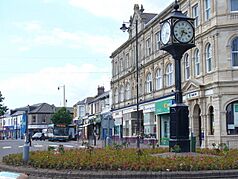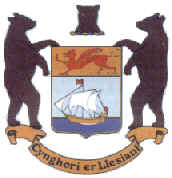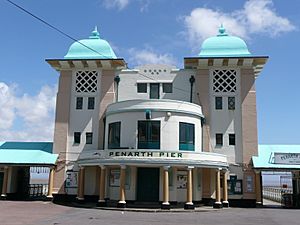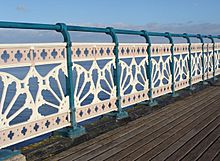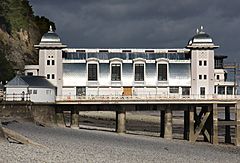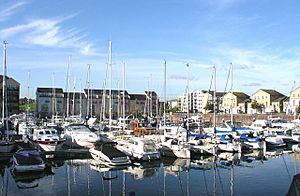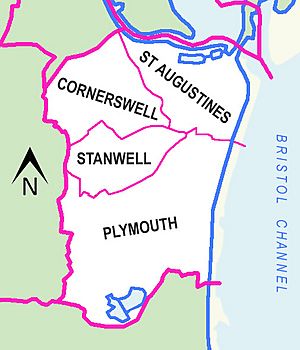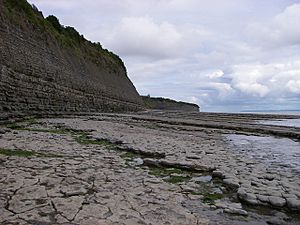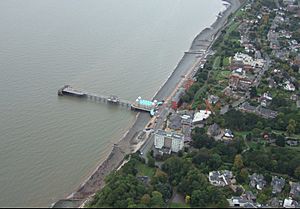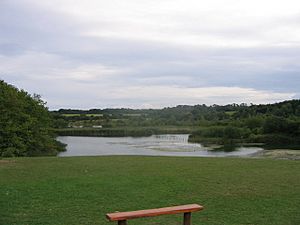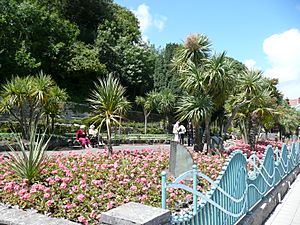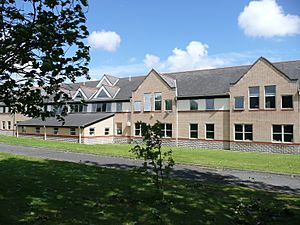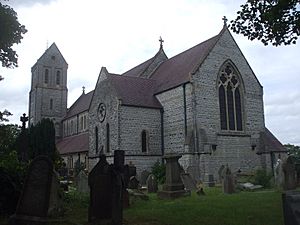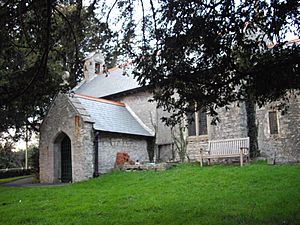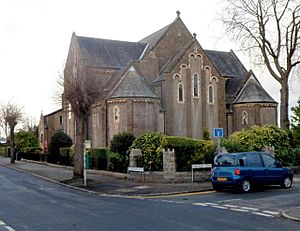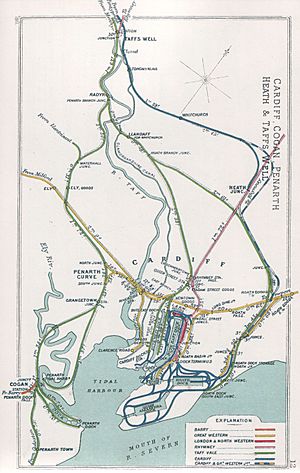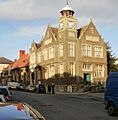Penarth facts for kids
Quick facts for kids Penarth |
|
|---|---|
|
|
|
| Population | 22,083 (2011) |
| OS grid reference | ST185715 |
| Community |
|
| Principal area |
|
| Ceremonial county | |
| Country | Wales |
| Sovereign state | United Kingdom |
| Post town | PENARTH |
| Postcode district | CF64 |
| Dialling code | 029 |
| Police | South Wales |
| Fire | South Wales |
| Ambulance | Welsh |
| EU Parliament | Wales |
| UK Parliament |
|
| Welsh Assembly |
|
Penarth is a town in the Vale of Glamorgan, Wales. It's about 3 miles (5 km) south of Cardiff city centre, right on the west shore of the Severn Estuary at the end of Cardiff Bay.
Penarth is a popular seaside resort. It's the second largest town in the Vale of Glamorgan, after Barry.
During the Victorian era, Penarth was a very popular holiday spot. People called it "The Garden by the Sea." Many visitors came from the Midlands and the West Country, plus day trippers from the South Wales valleys. Most arrived by train.
Today, Penarth still attracts summer visitors, especially older people. However, fewer people visit now compared to the past, partly because of cheap overseas holidays. The town has many retired people, making up over 24% of its residents. Penarth is also a "dormitory town," meaning many people live here but travel to Cardiff for work. In 2001, the town had a population of 20,396.
Penarth still has many beautiful old buildings from the Victorian era and Edwardian era.
Contents
What's in a Name?
The name Penarth comes from the Welsh language. For a long time, people thought it meant 'Head of the Bear' because pen means head and arth means bear. This idea is even shown on the town's coat of arms, which has bears on it!
However, modern experts think the name might come from "Pen-y-garth." Here, garth means cliff, so it would mean 'Head of the cliff' or 'Clifftops'. The Welsh-English dictionary also says penardd/penarth can mean 'promontory' (a piece of land sticking out into the sea).
The town's coat of arms was designed in 1875. It shows a bear's head and two bears holding a shield. The shield has a red dragon to show it's in Wales, and a sailing ship to remember Penarth's history with sea trade.
Penarth's Story
Early Days
People have lived in the Penarth area for at least 5,000 years. Stone axe heads from the Neolithic (New Stone Age) period were found here in 1956. Many Roman rings and coins were also discovered nearby.
From the 1100s until 1543, the land in Penarth belonged to religious groups from Bristol. The old Norman church of St Augustine, on the headland, is from this time. Later, the land was leased to the Earls of Plymouth. In 1853, they bought the land completely.
The oldest building in the area is a Tudor mansion called Cogan Pill. It was once owned by the Herbert family and is now a restaurant.
In the 1570s, there was a problem with pirates along the coast near Penarth! Some important local families were thought to be involved.
Penarth also had a medieval Sheriff's Pound. This was an early type of gaol (jail) where stray animals were kept, and sometimes thieves or vagabonds were imprisoned. It was used until the late 1700s.
In 1803, Penarth had several farms. By 1851, it was still a small farming and fishing village with only 24 houses and 105 people. Before the pier and dock were built, small fishing boats worked from the main town beach.
The Plymouth estate controlled how the new town was built. They offered 99-year leases for homes. This meant that most householders were tenants of the Plymouth Estates. This changed in 1967 when a new law allowed people to buy their homes outright.
The first homes in Penarth were terraced houses with shops and pubs on many corners. Local grey limestone was used, giving the older buildings a special look. Rich shipping owners from Cardiff built large villas along the cliffs. They wanted a more peaceful life away from the busy city.
Victorian Growth
By 1861, Penarth's population had grown to 1,898, and by 1871, it was 3,382. In 1875, Penarth, Cogan, and Llandough joined together, and the population reached 6,228 by 1881. This number doubled by 1891 when the railway opened, reaching 14,228 by 1901.
Penarth grew so much because of the huge increase in coal mining in the 1800s. Penarth was close to Cardiff, which was a natural place to send coal from the industrial valleys of Glamorgan. Penarth's waterfront was perfect for building docks to ship Welsh coal around the world.
The town grew quickly and became self-sufficient. It had its own local government, a busy shopping area, and many new community buildings. Windsor Road, now the main shopping street, was originally houses. Owners added shops by using their front gardens.
Many of the town's beautiful buildings and parks were created thanks to the landowners of the time. This is why Penarth became known as "The Garden by the Sea." A large part of the town is now a Conservation Area because of its special Victorian and Edwardian architecture. Penarth's library opened in 1905, thanks to a gift from the Carnegie Trust. The gothic-style Police Station and town jail opened in 1864.
When the railway connected to the Welsh valleys in 1878, many day-trippers started coming, especially on weekends and holidays. The growing summer holiday business was supported by many hotels, offering nearly two thousand beds. The biggest hotels included the Esplanade Hotel, The Marine Hotel, and The Royal Hotel. Most of these hotels have now closed.
A Royal Navy minesweeper called HMS Penarth was named after the town in 1918. It was sunk in 1919 after hitting two mines.
At one time, Penarth had two grand cinemas. The Windsor Kinema on Windsor Road was a former army drill hall. The even grander Washington Cinema, built in 1936, had a beautiful 'Art Deco' front. It closed as a cinema in 1971 and is now a coffee house and art gallery.
Another distinctive art deco building was the General Post Office (GPO) built in Albert Road in 1936. It closed in the 1980s and is now empty, but it's a Grade II listed building, meaning it's protected.
Penarth Dock
Work on Penarth Dock began in 1859 and it opened six years later. About 1,200 mostly Irish workers called 'navvies' built it. At its busiest in 1913, ships carried over 4.6 million tons of coal out of Penarth docks in one year! In 1886, Isambard Kingdom Brunel's famous ship, SS Great Britain, sailed from Penarth Dock on its last voyage. It caught fire and ended up in the Falkland Islands.
Penarth Dock had a special tunnel that connected it to Ferry Road in Grangetown, going under the River Ely. This tunnel was used by people walking and cycling to work in Cardiff. It was about half a mile long, lined with cream and green tiles, and lit by gas, then electricity. The tunnel opened in 1899 but closed in 1965 because of safety concerns and high maintenance costs. A new path for walkers and cyclists across the Cardiff Bay Barrage opened in 2008, replacing this historic shortcut.
Penarth Pier
Because Penarth beach was becoming popular, and to improve travel to Cardiff, a ferry service started in 1856. Boats were loaded using a special landing stage on wheels.
In the 1880s, people tried to build a permanent pier, but it stopped when the builders went out of business.
The Penarth Pier Company was then formed, and a second attempt was made. The pier opened successfully in 1895, stretching 750 feet (229 m) long.
In 1907, a small wooden theatre was built at the end of the pier. In 1929, Penarth Urban District Council bought the pier. They added a new berthing pontoon (a floating dock) and, in 1930, the famous art deco pavilion was built. In 1931, a fire started in the theatre, but all 800 people on board were saved. The pier was rebuilt, but without the wooden theatre.
In 1947, a large steamship, the SS Port Royal Park, crashed into the pier, causing a lot of damage. It took several years to repair. In 1966, another pleasure steamer, the Bristol Queen, also hit the pier.
In 2011, plans were approved for a £3.9 million project to fix up the pier and reopen the pavilion as a major attraction. The plans included a cinema and an observatory. Work began in 2012, funded by the Lottery, the Welsh government, and other groups. The pavilion reopened in autumn 2013.
Wartime Penarth
Life During Wartime
Because of its busy docks and closeness to Cardiff's docks and steelworks, Penarth was a target for Nazi German bombing during World War II. Air raids started in 1941 and continued for four years.
Penarth had its own Home Guard to help defend the town.
To build tanks and aircraft, scrap metal was needed. Hundreds of Penarth homes lost their traditional Victorian iron railings from their front gardens. Even All Saints' Church lost its fancy gates.
Strict food rationing meant people had to find food wherever they could. The town's parks, playing fields, and even front gardens were dug up and used as allotments to grow vegetables. The seafront and pier were full of people trying to catch fish to add to their food rations. There was also a special 'British Restaurant' where families who had lost their homes or needed help could buy a cheap meal.
Military Presence
Many members of the Penarth Yacht Club volunteered for the Dunkirk evacuation. They sailed their yachts and motor boats across the English Channel to France to help rescue soldiers.
The Glamorganshire Golf Club in Lower Penarth had an experimental rocket battery, which often scared residents with its practice firings. Lavernock Point was home to Lavernock Fort, with large naval guns, anti-aircraft guns, and searchlights. It also had the town's Royal Observer Corps post, which sounded the air raid sirens.
At the start of the war, over 350 soldiers were stationed on Flat Holm island. It was armed with guns and searchlights to protect shipping. In 1943, a group of American Seabees (US Construction Corps) lived on a ship in Penarth docks. They built many Quonset huts for the rapid expansion of Llandough Hospital and Sully Hospital.
Bombing Raids
One night in 1942, All Saints' Church was hit by incendiary bombs and completely burned down, leaving only the outer walls. The church was rebuilt after the war and reopened in 1955. Albert Road School was also badly damaged by fire but was quickly repaired. St Paul's Methodist Church, overlooking the docks, was completely destroyed. Many homes were also hit by bombs.
D-Day Preparations
In October 1943, a United States Navy Base was set up at Penarth Docks (now Penarth Marina). From here, many troops left for the D-Day invasion of Normandy. The base was led by Captain Arnold Winfield Chapin. He gave a painting of Penarth Docks in 1944 to "the people of Penarth," which is now in the town council's Kymin House.
In 1944, Penarth dock and the dock beach were full of invasion barges. These barges carried American Sherman tanks and their US Army crews, who had been staying in Penarth after training. They lived in a large village of huts built in 'Neale's Wood'.
British Commando units trained on the Penarth cliffs to prepare for scaling the Normandy cliffs. Some invasion barges were not used and lay on the dock beach for years, becoming playthings for local children.
After the War
Thousands of bombs were dropped on Penarth during the war. Even as late as the 1970s, unexploded bombs were still being found on the beaches between Penarth and Cardiff.
Penarth Today
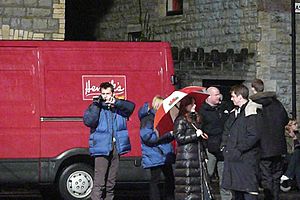
The coal trade from Penarth docks eventually stopped, and the docks closed in 1936. They only reopened for commercial and military use during World War II. From the 1950s until 1965, the docks were used by the Royal Navy to store dozens of warships that were no longer needed.
By 1967, after about a hundred years, the docks area was unused and empty. Much of it was filled in with waste. The largest dock basin is now completely filled in and covered with grass.
In 1987, the new Penarth Marina village opened on the old docks site. The main dock and outer basin were dug out again to create about 350 berths for yachts. Modern homes and marine businesses were built around them. The original dock office is now a popular restaurant. The Penarth Marina development helped kickstart similar projects in the Cardiff Bay area.
Penarth is one of the wealthiest areas in the Vale of Glamorgan, and property prices are high. Marine Parade, also called 'Millionaires' Row', has grand Victorian houses and modern villas with views across the Bristol Channel. Many of the large Victorian homes in Penarth have been converted into flats or care homes. Penarth Marina has trendy modern townhouses and apartments.
In 1930, the General Post Office (GPO), later British Telecom (BT), built its main telephone engineers' college in Penarth. Engineers from all over the UK came here for courses. The college closed in the 1980s and was later replaced by new homes.
In 1965, Cardiff Universities built International House on Plymouth Road. It was a Halls of Residence for up to 300 international students. It closed in the late 1990s and is now a special residential care home.
Penarth has been used as a filming location for several BBC TV series, including Doctor Who (the scene where a Dalek shoots The Doctor was filmed at the junction of Arcot Street and Queen's Road). Scenes for Torchwood, The Sarah Jane Adventures, Gavin & Stacey, and Casualty have also been filmed here. Since 2021, the Netflix series, Sex Education, has filmed in places like The Paget Rooms and Penarth Pier. In July 2024, actor Timothy Spall was seen filming on Penarth Pier for the BBC series Death Valley.
Penarth was named one of the best places to live in Wales in 2017.
Economy
In the Victorian era, Penarth relied on tourism, which led to the building of Penarth Pier in 1894. Today, Penarth's main shopping street is Windsor Road. Most jobs in Penarth are in local services. However, the town also has some larger companies, including EKF Diagnostics and the financial tech company Wealthify.
How Penarth is Governed
Town Council
Penarth is divided into four electoral wards: Plymouth, Stanwell, Cornerswell, and St Augustine's. Plymouth and Stanwell are named after main roads. Cornerswell includes the Cogan community and the Poet's Estate, where roads are named after famous writers like Wordsworth and Milton. St Augustine's ward covers the Marina, Penarth Head, and the town centre.
Currently, the wards of Cornerswell, Stanwell, and St Augustine's are represented by the Labour Party. Plymouth ward is represented by the Conservative group in the Vale of Glamorgan County Council. The leader of the Penarth Town Council is Cllr Rhiannon Birch.
The "Mother" of the Town Council, who is the longest-serving councillor, is Cllr. Rhiannon Birch.
The current mayor (2023/24) is Cllr Melissa Rabiotti.
Vale of Glamorgan Council
Penarth's four wards also elect county councillors to the Vale of Glamorgan Council. St Augustine's ward is represented by Cllrs Elliott Penn, Neil Thomas, and Ruba Sivagnanam (all Labour). Plymouth Ward is represented by Cllr Anthony Earnest and Cllr Rhys Thomas (Conservatives). Cornerswell Ward is represented by Cllrs Rhiannon Birch and Ian Buckley (Labour). Stanwell Ward is represented by Cllr Mark Wilson and Cllr Lis Burnett (Labour).
Westminster
The Member of Parliament (MP) for Penarth is Stephen Doughty (Labour & Co-operative Party). He was re-elected in December 2019.
Geography
Coastline
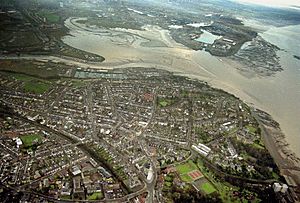
Penarth is about 4 miles (6.4 km) southwest of Cardiff by road. Its road system has improved a lot recently, and it also has a traditional rail link. The Cardiff Bay Barrage, a barrier between Penarth Head and Grangetown, was finished in 1999. It created a large freshwater lake in Cardiff Bay. A path for walkers and cyclists across the barrage opened in June 2008, connecting Penarth to Cardiff.
An imaginary line from Lavernock Point, just 2 miles (3.2 km) southwest of Penarth, to Sand Point, Somerset marks the end of the Severn Estuary and the start of the Bristol Channel. So, Penarth is technically in the Severn Estuary. Because of the huge tidal range, there are very strong currents close to the shore. The tides at Penarth are the second highest in the world! Sometimes, when certain moon phases combine with spring and autumn equinoxes, the sea can even flood the road along the seafront.
Soils and Cliffs
The land around Penarth is mostly limestone. This rock was formed under a warm prehistoric sea and then shaped by ice age glaciers about 18,000 years ago. This created rich, brown soil, perfect for farming in medieval times. The limestone was also used for nearly a hundred years at the Cosmeston quarry, which supplied a cement factory. The quarry closed in 1970 and became Cosmeston Lake in the country park.
The town sits on top of cliffs with a unique rock formation called the Penarth Group. These cliffs are made of layers of limestone and alabaster, which are both dry and crumbly rocks. Penarth cliffs have the largest known natural outcrop of pink alabaster in the world.
The crumbly nature of the rocks means the cliffs are constantly being worn away by the sea. Rockfalls happen often, so walkers on the beach should stay away from the base of the cliffs. A rusty sign warns people in three languages: "Caution: Beware of stones falling from the cliff. Beware of being caught by the high tides." The cliff has moved back many metres even in recent memory, with Penarth Head being most at risk.
Population
The population figures from the United Kingdom Census 2001 are:
- Population: 22,083
- Average age: 42
- Retired people: 5,904
- People with a degree: 7,457
Seafront and Town Centre Improvements
Even with town centre improvements, many Victorian hotels and houses along Penarth seafront have been pulled down since the 1980s and replaced with modern apartment blocks. The theatre and bars on the pier were left to decay, though the pier itself stayed open.
In 2008, plans were announced to develop the pier's empty pavilion. This £2 million project, funded by the Lottery, planned to include a cinema, theatre, cafe, gallery, bar, and a large multi-purpose area. The Vale of Glamorgan council gave £800,000 to help start the Lottery application. In 2009, the National Lottery Heritage Fund gave £99,000 for further planning. Full funding was secured in 2011, and restoration work began in February 2012.
Places to Visit
Cosmeston Lakes Country Park has been a popular place since it opened in 1970. It has a lake, many water fowl, and pleasant walks in woodlands. Cosmeston Medieval Village is open daily and has historical re-enactments on summer weekends and holidays. This reconstructed village is considered one of the best in Britain.
Turner House Gallery is on Plymouth Road. It's an exhibition space for Ffotogallery, Wales' national photography agency. It shows regular exhibitions of photography, video, and new media art. The gallery opened in 1888 to house the art collection of local resident, James Pyke Thompson. There's also a small art gallery at the Washington Buildings, which is a converted 1930s art deco cinema.
The Paget Rooms hosts dances, occasional pop concerts, and plays by local drama groups. The singer Tom Jones played one of his last UK concerts here before moving to America. The Welsh band Man once recorded a live album at the Paget Rooms.
The beach front promenade is still a popular spot for visitors. The Victorian pier is used as a summer stop for pleasure steamers that sail in the Bristol Channel. It's also a popular place for sea fishing in winter. The historic Penarth Yacht Club, built in 1883, stands next to the new RNLI lifeboat station and its shop. There are also many popular cafes and restaurants on the seafront. The seafront remains natural, without the amusement arcades found at other traditional holiday resorts. The town's swimming pool, built in the late 1800s, closed in the 1980s and is now converted into flats, but its Victorian outside remains.
The clifftop walks to Lavernock, St Mary's Well, and Swanbridge are popular. These areas have beaches and the historic hut where Marconi first sent radio messages over open sea. The old railway track, which once connected Penarth to Cadoxton and Barry Island, is now a greenway and cycle track. The main part of the Lavernock Fort gun battery is now an Ancient Monument. The Lavernock Point Nature Reserve is managed by the Wildlife Trust.
Penarth has a two-week-long Penarth Holiday Festival every July since 1966. It includes special events like pop concerts, yacht races, parades, fairs, tea dances, art exhibitions, and fireworks. In 1970, the festival ended with an air display by the Red Arrows over the cliffs and sea.
Town Parks
Alexandra Gardens is the town's main Victorian park, opened in 1902. It has flowerbeds, an ornamental fishpond, a bandstand, and the town's Cenotaph memorial to those who died in the world wars. The park leads from the town down to the seafront, almost connecting with Windsor Gardens Park, which runs along the esplanade. On the seafront itself is the Victorian Italian Garden, with many unusual palm trees and exotic plants. All three parks are listed for their special historic interest in Wales.
Education
Secondary Schools
St Cyres Comprehensive School focuses on its Welsh Baccalaureate program. It has two sites: years seven to nine are in both Penarth and nearby Dinas Powys, and years ten to thirteen are only in Penarth. A new school building, the Penarth Learning Community, was completed in 2012, offering excellent facilities. The main primary schools that feed into St Cyres are Llandough, Fairfield, Cogan, and all primary schools in Dinas Powys. In 2008, St Cyres became the first fairtrade secondary school in Penarth, and in 2022, it became the first School of Sanctuary in the Vale.
Stanwell School is a co-educational comprehensive school for students aged 11 to 18. The school has received millions of pounds for new buildings, facilities, and equipment. It has special teaching areas for Science (with eleven modern labs), drama, music, media studies, P.E. (including sports halls), Information Technology, Art, and Design Technology. The school has about 2,000 students, including a busy sixth form. The main primary schools that feed into Stanwell are Albert Road, Victoria, Evenlode, and Sully Primary School.
Westbourne School is a small coeducational independent day school, nursery, and prep school for children aged 3 to 18. It is located on the corner of Stanwell Road and Hickman Road. The school has 162 students and is housed in two buildings. Class sizes are small, ranging from 9 to 17 students. Westbourne School opened its new sixth form in 2008 and offers the Diploma Programme of the International Baccalaureate Organisation. The school consistently achieves excellent academic results and is known as a high-achieving school.
Primary and Nursery Schools
Primary schools in Penarth include Cogan County Primary, Ysgol Pen-y-garth (Welsh medium), St Joseph's Roman Catholic Primary and Nursery School, Fairfield County Primary, Victoria Primary, Albert Road Primary, Evenlode Primary, and Llandough Primary School.
Places of Worship
Local church sites are:
- St Augustine's Church is on Penarth Headland. The original church on this site probably dated from 1240. It was pulled down in 1865, and a new, much larger church was built in 1866. It cost £10,000 and was paid for by Harriet Windsor-Clive, 13th Baroness Windsor. It was designed by the famous Victorian architect William Butterfield. The inside uses different coloured bricks and stone. The distinctive tower of the old church was kept in the new design because it appeared on navigation maps. St Augustine's is a Grade I listed building. The churchyard cross is medieval and from the original church.
- St Peter's Church, also known as Old Cogan Church, is a Church in Wales church off Sully Road. It might have been a wooden structure built as early as 800 AD. The current stone building is one of the oldest church buildings in the Vale of Glamorgan.
- All Saints Church in Wales is in Victoria Square. It was built in 1892 by the Earl of Plymouth. The church was destroyed by a German air raid in 1943 but was rebuilt and reopened in 1955.
- St. Joseph's Roman Catholic Church is on Wordsworth Avenue. The original church and school were built in 1873.
- Trinity Methodist Church is in Woodland Place. The current church, built in 1901 in a Gothic style, has the only spire left in the town. It was designed by Henry Budgen. The church was damaged several times by bombing during World War II. In 1970, a day centre for the elderly was started, and in 1986, the school rooms were changed to create meeting rooms, a youth club, kitchens, and toilets.
- Eden Church Penarth meets in the Upper Hall of Trinity Methodist Church and was started in 2014.
- Albert Road Methodist Church is at Albert Road and Albert Crescent.
- Tabernacle Baptist Chapel is in Plassey Street.
- Hebron Church is on Pill Street, Cogan.
- The United Reformed Church is on Elfed Avenue.
- The Jehovah's Witnesses Kingdom Hall is on Plassey Street.
Sports and Fun
Penarth has both Men's (started 1911) and Ladies' (started 1896) Hockey Clubs that play at a high level. The Men's 1st XI has been promoted several times and even played in a EuroHockey competition in Ukraine in 2017.
Penarth Cricket Club was founded in 1851, making it one of the oldest in South Wales. It plays in the South Wales Premier League. The club now plays at The Athletic Ground on Lavernock Road, a site given to the town in 1924. This ground is shared with Penarth Rugby Club and Penarth Hockey Club. Penarth Lacrosse Club has also developed players who have represented Wales.
The famous Penarth Rugby Football Club is also based at The Athletic Ground. It used to host the world-famous Barbarians Football Club every Easter Good Friday until 1986. Penarth has a second rugby club, Old Penarthians RFC, originally for former students of Penarth County Grammar School.
Penarth has three football (soccer) clubs. Cogan Coronation AFC, known as the 'Coro', was founded in 1960. Inter Penarth AFC has been running for over 12 years. Penarth Town AFC is a newer club.
Glamorganshire Golf Club in Lower Penarth is considered one of the best golf courses in Wales. It was established in 1890. In 1898, the club was where Dr Frank Stableford tested his new Stableford golf scoring system, which is still used worldwide today.
Penarth has two tennis clubs: Penarth Lawn Tennis Club and Windsor Lawn Tennis Club. Penarth Lawn Tennis Club is the second oldest tennis club in Wales (established 1884).
Cogan Leisure Centre is a modern sports venue with a leisure pool and large playing fields. The new Cardiff Sports Village is also close by.
Penarth Sea Cadets are located in the town.
Cardiff Morris performs traditional dances from Wales and England. They meet weekly in Penarth.
Penarth Amateur Boxing Club now meets in Station Road.
Penarth Bowls Club is on Rectory Road, on what was once a deep limestone quarry.
South Wales Comedy Writers Society is based in Penarth.
Penarth is also home to a Waterski club, which has produced regional, national, and European champions in Waterski Racing.
Getting Around
Penarth railway station is the end of the Penarth branch of the Vale of Glamorgan Line from Cardiff. It's part of a line originally built in 1865 to serve the new docks. Penarth Dock railway station used to serve the docks but closed in 1962. All train services are run by Transport for Wales. Dingle Road station is also near the town centre. The Barry branch of the line passes through Cogan railway station.
Cardiff Bus services connect Penarth to Cardiff City Centre, with some buses continuing to Barry. Penarth is also served by First Cymru buses.
The Paddle Steamer Waverley and MV Balmoral sail from Penarth pier to seaside resorts in west Somerset and North Devon, like Minehead and Ilfracombe. This tradition has continued for over 60 years.
The Cardiff Waterbus offers a passenger water taxi service between the Penarth end of the Bay Barrage and Mermaid Quay in Cardiff.
The Pont y Werin pedestrian and cycle bridge opened in July 2010, creating a 4.2-mile (6.8 km) circular route between Cardiff Bay and Penarth.
International Connections
Penarth shares its name with Penarth, Delaware in the US.
Penarth is twinned with:
 Saint-Pol-de-Léon in Brittany, France. They celebrated their fortieth twinning anniversary in 2010. There used to be regular meetings and student exchanges between the two towns. After a break, both towns are now keen to reconnect. In Penarth marina, there's a street named "Plas St. Pol De Leon."
Saint-Pol-de-Léon in Brittany, France. They celebrated their fortieth twinning anniversary in 2010. There used to be regular meetings and student exchanges between the two towns. After a break, both towns are now keen to reconnect. In Penarth marina, there's a street named "Plas St. Pol De Leon."
Famous People
Many notable people have been born, lived in, or are connected with Penarth. These include politicians like Saunders Lewis, the founder of Plaid Cymru, and Alun Michael MP. Three people from Penarth have received the Victoria Cross, including Dambuster's leader Guy Gibson.
Sports stars linked to Penarth include Colin Jackson, Dame "Tanni" Grey-Thompson, and professional NFL American football player Louis Rees-Zammit.
Penarth is also connected to many people in the performing arts, such as novelist Eric Linklater, actors Colin McCormack and Ronan Vibert, actress Erin Richards, composer Joseph Parry, French Impressionist painter Alfred Sisley, and singers Jem, Shakin' Stevens, and Martin Joseph.
Images for kids
-
A view of the Penarth coast from the Bristol Channel
See also
 In Spanish: Penarth para niños
In Spanish: Penarth para niños


